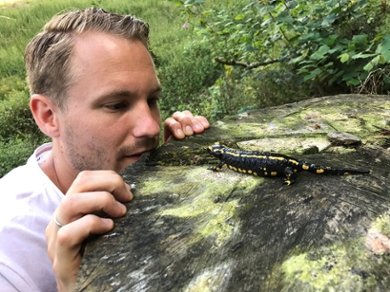Willem Meilink
PhD candidate / contract
- Name
- W.R.M. Meilink MSc
- Telephone
- 071 5274882
- w.r.m.meilink@biology.leidenuniv.nl

I am a high school teacher (Thorbecke Talentschool Rotterdam) and PhD candidate with a promotiebeurs voor leraren (NWO grant). I work on the Balanced Lethal System in Triturus, a system in which 50% of all offspring is lost each generation. I also guide pupils with lab work during their ‘profielwerkstukken’.
More information about Willem Meilink
Supervisor(s)
See also
Research
At the University of Leiden and Naturalis I work on the Balanced Lethal System (BLS) in Triturus, a system in which 50% of all offspring is lost each generation. The driver for this system is the heteromorphic chromosome 1, that results in death for offspring that are homomorphic for this chromosome. I designed two methods (multiplex KASP and multiplex PCR) to genotype individuals whether they suffer from the BLS, and used KASP to study the recombination over the genome in Triturus, and rather the lack thereof on chromosome 1. I also will use ddPCR to count the amount of copies of markers present on chromosome 1, as they are expected to be single copy. Finally, also using ddPCR the same strategy will be used to show differences in copy number in triploid individuals.

Brief biography
From early childhood I have been fascinated by amphibians. At an early age I looked for frogs in our garden pond and their lifecycle already fascinated me enormously. Since the age of 7 I have had my pet newt – a Spanish ribbed newt – Godzilla.
My fascination with amphibians prompted me to study biology and it was during my bachelor that I got my first experience with newts in the wild during my fieldwork in France. I performed this fieldwork under the supervision of Annie Zuiderwijk and Pim Arntzen. During my bachelor I also did an education minor which led to my teachers degree.
For my master I decided to study herpetology in Brussels, the branch of zoology specializing for amphibians and reptiles. Once more, I performed fieldwork and got some papers out of my studies. For my master thesis I studied the hybridization between the native crested newt (Triturus cristatus) and its Italian congener (T. carnifex) under the supervision of Ben Wielstra. My master thesis was published in Biological Conservation (Meilink et al., 2015), and I presented my results at several herpetological congresses.
I started teaching biology after my studies. This year is my fifth year as a teacher, and I love my work tremendously. However, although my daily life is filled with many beautiful and emotional moments, some of which rarely offered by science, it does lack a certain challenge for the cognitive mind that I notice I miss in my job. That prompted me to write a research proposal that would allow me to once more intertwine teaching and research. I have been honoured with the grant: promotiebeurs voor leraren, which will allow me to perform research.
Grants
Promotiebeurs voor leraren: Aanvraagronde 2020 I
Key publications
Meilink, W.R.M., van Beek, F.D., van de Breevaart, I., de Geus, S., Hellendoorn, c., Jahangier, F., Lim, A., Sluimers, M., Wali, A.M., van delft, J.J.C.W., Herder, J.E., France J., & Wielstra B. Difficulties in species identification in water frogs (genus Pelophylax) using morphological and molecular markers in the Netherlands. Alytes. 41 (1-4): 49 -55. 2024.
Arntzen, J.W., Abrahams, C., Meilink, W.R.M., Iosif, R., Zuiderwijk, A. Amphibian decline, pond loss and reduced population connectivity under agricultural intensification over a 38 year period. Biodiversity Conservation. 26:1411-1430. 2017.
Meilink, W.R.M., Arntzen, J.W., van Delft, J.J.C.W., Wielstra, B. Genetic pollution of a native threatened crested newt species through hybridization with an invasive congener in the Netherlands. Biological Conservation. 184. 145-153. 2015.
PhD candidate / contract
- Faculty of Science
- Institute of Biology Leiden
- IBL Animal sciences & health
- Meilink W.R.M., Cvijanović M., Visser M.C. de, France J.M., Ivanović A., Theodoropoulos A., Vucic T. & Wielstra B.M. (2025), Exposing selection and genetic linkage in the evolutionary enigmatic balanced lethal system in Triturus newts, Ecology and Evolution 15(6): e71591.
- Meilink W.R.M., Visser M.C. de, Theodoropoulos A., Fahrbach M. & Wielstra B.M. (2025), Determining Zygosity with multiplex Kompetitive Allele‐Specific PCR (mxKASP) genotyping, Ecology and Evolution 15(6): e71642.
- Meilink, W.R.M., Beek F.D. van, Breevaart I. van de, Geus S. de, Hellendoorn C., Jahangier F., Lim A., Sluimers M., Wali A.M., Delft J.C.W. van, Herder J.E., France J.M. & Wielstra B.M. (2024), Difficulties in species identification in water frogs (genus Pelophylax) using morphological and molecular markers in The Netherlands, Alytes 41(1-4): 49-55.
- Robbemont J., Van Veldhuijzen S., Allain S.J.R., Ambu J., Boyle R., Canestrelli D., Cathasaigh É.Ó, Cathrine C., Chiocchio A., Cogalniceanu D., Cvijanović M., Dufresnes C., Ennis C., Gandola R., Jablonski D., Julian A., Kranželić D., Lukanov S., Martínez-Solano I., Montgomery R., Naumov B., O’Neill M., North A., Pabijan M., Pushendorf R., Salvi D., Schmidt B., Sotiropoulos K., Stanescu F., Stanković D., Stapleton S., Šunje E., Szabolcs M., Vacheva E., Willis D., Zimić A., France J.M., Meilink W.R.M., Stark T., Struijk R.P.J.H., Theodoropoulos A., De Visser M.C. & Wielstra B.M. (2023), An extended mtDNA phylogeography for the alpine newt illuminates the provenance of introduced populations, Amphibia-Reptilia 44(3): 347-361.
- Visser M.C. de, France J.M., Meilink W.R.M. & Wielstra B.M. (2021), Een evolutionair raadsel: het dodelijke chromosoom 1 syndroom in Triturus-salamanders, RAVON 23(1): 9-12.
- Meilink W.R.M., France J., Visser M.C. de & Wielstra B. (2021), Balanced lethal systems: an evolutionary mystery, Frontiers for Young Minds 9: 632945.
- Meilink W.R.M., Arntzen J.W., Delft J.J.C.W. van & Wielstra B.M. (2015), Genetic pollution of a threatened native crested newt species through hybridization with an invasive congener in the Netherlands, Biological Conservation 184: 145-153.
- Wielstra B.M., Duijm E., Lagler P., Lammers Y., Meilink W.R.M., Ziermann J.M. & Arntzen J.W. (2014), Parallel tagged amplicon sequencing of transcriptome-based genetic markers for Triturus newts with the Ion Torrent next-generation sequencing platform, Molecular Ecology Resources 14(5): 1080-1089.


